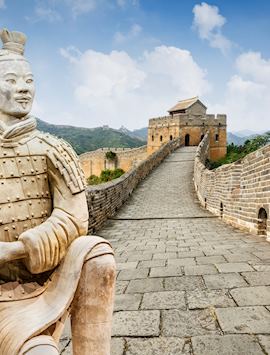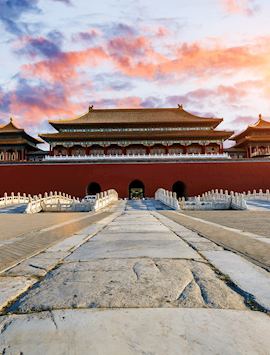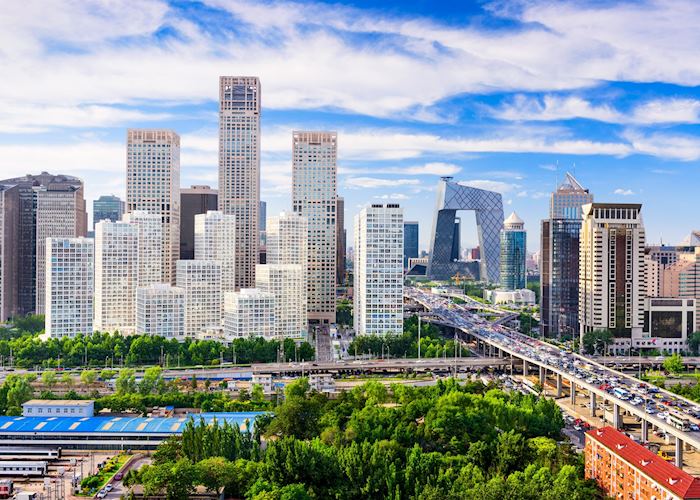Jump to:
With its long history evident in Ming-era palaces and temples, juxtaposed with modern skyscrapers and cutting-edge architecture, Beijing is a microcosm of China’s stark contrasts and contradictions. At the heart of it all is the Forbidden City, a vast complex of palaces, gardens and halls dating to the 15th century, once only accessible to emperors and their families. On the outskirts of the city are peaceful gardens where, as you stroll among the trees, you come across traditional halls and temples.
Modern-day Beijing is on show in the bustling markets selling electronics, gaudy trinkets and deep-fried crickets. Meanwhile, admiring the sleek design of the Olympic Park’s buildings is like glimpsing the future.
China specialist AliceBeijing is a true example of old and new China. Learning about its history brought home to me the incredible changes the city has undergone, from the time of the Tang dynasty all the way to present day.
Things to see and do in Beijing
The Great Wall
The Great Wall of China skirts contortedly around the northern edge of Beijing. Certain sections of the wall become busy with coach parties and domestic tourists, particularly those closest to the city. We recommend taking a two-hour private car journey to the quieter section at Jinshanling, around 130 km (80 miles) northeast of the city. Much of the wall here is original, featuring a complete defensive system including barrier walls, watchtowers, battlements, gun emplacements and shooting holes.
As you stroll along the wall at your own pace, taking in sweeping views of the surrounding hills, your guide tells you about its construction and tales from its past. The lack of other people means it’s easier to take photographs and you’re able to enjoy a more personal experience. After your walk, you can take a 15-minute cable car ride down from the wall for a different perspective.
The Temple of Heaven
 The vast Temple of Heaven complex in southeast Beijing was built between 1406 and 1420 for the use of Ming and Qing dynasty emperors during their annual prayers for a good harvest. A visit to the temple’s three main buildings with a private guide gives you an insight into Chinese history, religion and Ming dynasty architecture.
The vast Temple of Heaven complex in southeast Beijing was built between 1406 and 1420 for the use of Ming and Qing dynasty emperors during their annual prayers for a good harvest. A visit to the temple’s three main buildings with a private guide gives you an insight into Chinese history, religion and Ming dynasty architecture.
The huge park at the temple’s entrance serves as a communal leisure space for local people. Visiting early in the morning, you can watch them dancing, fencing, flag waving and practising the traditional art of t'ai chi. We can also arrange for you to take a private class in this centuries-old pastime with a t'ai chi master. You’ll learn some of the basic movements and techniques used to calm the body and mind.
The Forbidden City and Palace Museum
Consisting of 980 buildings dating back to between 1406 and 1420, the Forbidden City was home to 24 emperors across the Ming and Qing dynasties. For 500 years, the vast complex was off-limits to all but the current ruler and his family.
Today, you can visit the palaces, gardens, halls and living quarters of China’s past rulers. Red and gold dominate the buildings, which were built in a traditional style with large, wide roofs, enclosed courtyards and precise symmetry. Inside, you can admire intricate wood and marble carvings.
The Palace Museum is made up of 90 palaces and courtyards within the Forbidden City. It holds extensive collections of relics retrieved from the site, from paintings and ceramics to jade stone necklaces and everyday items used by the Forbidden City’s former residents.
Beijing’s markets
The entrepreneurial spirit of the Chinese shines through in Beijing’s many markets. On sale is anything from traditional wood carvings and herbal remedies to modern electronics and fake designer handbags.
Panjiayuan Antiques Market is an authentic flea market of around 3,000 stalls. The market mostly caters to the local populace, so you’re under less pressure to buy. With such a mix of items on offer, you could be looking at Ming-style carved wooden furniture at one stall before turning a corner to find Tibetan artwork, old coins or political posters at another.
Wangfujing is one of Beijing’s most renowned shopping areas, and many of its night markets focus on selling street food. Browsing Donghuamen Night Market in the northern end of the district, you’ll come across delicacies such as candied fruits and dumplings, and deep-fried crickets, scorpions and centipedes.
The Summer Palace
 Situated in northern Beijing’s Haidian District, the Summer Palace feels a world away from the city with its landscaped gardens, lake and temples dotted among trees.
Situated in northern Beijing’s Haidian District, the Summer Palace feels a world away from the city with its landscaped gardens, lake and temples dotted among trees.
While the site’s royal origins date back to the 12th century, the current palace and grounds were created during the 18th-century reign of Emperor Qianlong as a summer residence. Around 100,000 workers dug out Kunming Lake, which makes up three quarters of the grounds. The excess soil was used to form the 60 m (200 ft) high Longevity Hill.
Visiting today, you can admire the traditional architecture of the intricately decorated palace buildings while your guide relates the site’s history. A highlight is the 700 m (2,297 ft) ‘Long Corridor’, a covered walkway decorated with scenes from Chinese mythology.
Lining the water’s edge are traditional shops and teahouses you can browse. Climbing Longevity Hill, you’ll pass traditionally styled halls, gates and temples and, at the top, look over panoramic views of the lake.
Beijing’s hutongs
From as early as the medieval Yuan dynasty, Beijing’s residents lived in adjoining houses connected by a labyrinth of narrow lanes and courtyards, known as hutongs. Many have since been destroyed, but some have been protected and still stand. They provide a stark contrast to the grand palaces and manicured gardens of China’s rich and powerful.
You can head out with a guide on foot or join a tricycle tour of these historic lanes. Your guide will divulge the hutongs’ history and point out features such as the gate decoration once used to indicate a family’s status and door knockers embellished with dragons.
Close-knit communities are still formed within the hutongs. As you wind down the lanes, you might notice residents gossiping and children playing, see the public bathrooms they share, and come across local shops.
A more hands-on way to delve into the hutongs is through a cooking class or guided street-food breakfast tour. Cooking classes start with a visit to a local supermarket, where your guide will introduce you to some of the common ingredients used in Chinese cuisine, before your cooking class proper. This takes place in a private kitchen sequestered away in a traditional hutong courtyard home.
Meanwhile, street-food breakfast tours lead you around a tight grid of hutongs. You stop off at various stalls and small cafés to grab jianbing (similar to crêpes), youtiao (fried dough sticks dunked in soy milk), and fried pork dumplings, among many other dishes. En route and mid-munch, your guide tells you about breakfast food in Beijing, and offers titbits about Chinese food culture in general.
Fragrant Hills Park
Set at the foot of the Western Mountains in Beijing’s Haidian District, Fragrant Hills Park is an imperial garden established in 1186 and later expanded during the Yuan and Ming dynasties. Brightly decorated temples and halls scatter the landscape. The hills are covered with maple, smoke and persimmon trees whose leaves turn fiery red and burnt orange in October and November.
The park seems more suited to rural China than the outskirts of Beijing. There are several walking routes you can follow with your guide. One follows the north side of the park, past a small lake and several temples including the Tibetan-style Bright Temple complex.
Another explores the south, passing Tranquility Green Lake and Fragrant Temple and winding up to Incense Burner Peak, the park’s highest point. You can also take a cable car ride across the park for bird’s-eye views.
Lama Temple
Set in the grounds of what was once a 16th-century imperial court and eunuch house, this Tibetan lamasery is Beijing’s standout Buddhist temple. You walk through gates and up a wide pathway lined with ginkgo trees to reach a series of halls, each housing a different shrine. Prayer flags flap from poles, and the air is heavy with incense wafting up from burners.
No matter what time of day you visit, you’ll likely see devotees bowing and muttering prayers or devotions, and perhaps a yellow-robed monk or two. Inside the halls are statues of Buddha in varying sizes, but the whole complex is dotted with intriguing objects and devices used in Tibetan Buddhism. A separate museum area displays objects such as ritual daggers, mandalas, robes, prayer wheels and tantric statues.
The Olympic Park
 The 2008 Beijing Olympics shed a new light on the city and China as a whole. The venue’s modern architecture showed how much China has developed over the last few decades. You can now visit the Olympic Park with a guide to admire its futuristic buildings and learn about their design.
The 2008 Beijing Olympics shed a new light on the city and China as a whole. The venue’s modern architecture showed how much China has developed over the last few decades. You can now visit the Olympic Park with a guide to admire its futuristic buildings and learn about their design.
You’ll see the National Stadium (or Bird’s Nest), with its distinctive twig-like structure wrapping around its bowl-shaped roof. Also on the tour is the National Aquatics Center, or Water Cube, a blue box-shaped building covered in semi-transparent ‘bubbles’.
We recommend heading to the top of the 250 m (820 ft) Olympic Park Observation Tower. Built in 2014, its design was inspired by blades of grass. From its open-air deck, you can gaze over the park and southern Beijing on a clear day. Or, look down through the partially glass floor to see the ground far below.
Best time to visit Beijing
September is considered the best time to visit, when the heat and rains of the summer have subsided. Daytime temperatures are still warm, while nights are cooler. May is also a popular time as temperatures are pleasant but not yet hot and humid. November is the best time to see the seasonal foliage. In December and January, temperatures are cold and snow is possible, but there are fewer visitors. Domestic tourism during the national break in early October results in price rises and busier sites.
Festivals, events and seasonal reasons to visit
- Chinese New Year (or the Spring Festival) falls in late January or February. People attend Beijing's traditional temple fairs for ritual praying, entertainment, snacks and markets.
- Taking place each July, the Beijing Dance Festival is one of the biggest celebrations of dance in China. More than 250 dance artists perform to large crowds.
- Falling on the 15th day of the 8th month according to the Chinese lunar calendar, the Mid-Autumn Festival involves lunar worship and moon watching. It’s the second-largest festival after Chinese New Year and is celebrated in temples and parks throughout Beijing. Mooncakes (round pastries filled with red bean or lotus seed paste) are a popular delicacy around this time.
- The Red Leaf Festival is usually held in mid-October at Fragrant Hills Park. Visitors gather to admire the red seasonal leaves.
who's been there
-
01993 838 92501993 838 220
- Make an enquiry
Suggested itineraries featuring Beijing
Our itineraries will give you suggestions for what is possible when you travel in Beijing, and they showcase routes we know work particularly well. Treat them as inspiration, because your trip will be created uniquely by one of our specialists.
Photos of Beijing
Our expert guides to exploring Beijing
Written by our specialists from their own experiences of visiting Beijing, these guides will help you make the most of your time there. We share both our practical recommendations and the best ways to appreciate Beijing at its best.
-
Characterful stays in China ![Songtsam Hotel, Shangri-la]()
Characterful stays in China
Characterful stays in China
Whether you’re staying in a converted farmhouse surrounded by countryside or a traditional Tibetan building overlooking a monastery, basing yourself in a boutique property during your holiday to China opens your eyes to new cultures and authentic local life. Country specialist Stephanie shares her recommendations.
Read this guide -
A guide to Chinese food (and where to find it) ![Dumplings, China]()
A guide to Chinese food (and where to find it)
A guide to Chinese food (and where to find it)
There’s more to Chinese food than Western takeaways let on. Each region of China has its own distinct cuisine, from the west’s hot and spicy delicacies to the hearty dishes of the north. China specialists Anthony and Duncan discuss the best ways to experience food in China.
Read this guide -
China’s spiritual side: the best temples, grottoes, mosques and mountains ![Songzanlin Monastery, Shangri-la]()
China’s spiritual side: the best temples, grottoes, mosques and mountains
China’s spiritual side: the best temples, grottoes, mosques and mountains
You can explore spiritual China in country specialist Anthony’s guide to the Middle Kingdom’s most intriguing holy places. He shares his thoughts on the why and how of visiting Buddhist monasteries, temples and cave art, and even sacred mountains.
Read this guide -
The Great Wall of China: taking a quieter path ![Great Wall of China]()
The Great Wall of China: taking a quieter path
The Great Wall of China: taking a quieter path
Unmistakable in its appearance and scale, the Great Wall of China wends across the hills, mountains and valleys of northern China. For most visitors, blanking out time to visit this man-made wonder is a must — China specialist Susan outlines the best ways to do this.
Read this guide
Accommodation choices for Beijing
We've selected a range of accommodation options for when you visit Beijing. Our choices usually come recommended for their character, facilities and service or location. Our specialists always aim to suggest properties that match your preferences.
-
![The Aman Summer Palace, Beijing, Beijing]()
Aman Summer Palace
Beijing -
![Double Happiness Courtyard Hotel, Beijing]()
Double Happiness Courtyard Hotel
Beijing -
![Cote Cour Courtyard]()
Unified Courtyard Hotel
Beijing -
![Tsars Gold Private Train]()
Tsars Gold Private Train
Beijing -
![Deluxe Room, Peninsula Hotel, Beijing]()
Peninsula Beijing
Beijing -
![Peace Hotel Lobby]()
Novotel Beijing Peace
Beijing -
![The Regent Beijing]()
The Regent
Beijing -
![Shichahai Shadow Art Hotel, Beijing]()
Shichahai Shadow Art Hotel
Beijing
Ideas for experiencing Beijing
Our specialists seek out authentic ways to get to know the places that could feature in your trip. These activities reflect some of the experiences they've most enjoyed while visiting Beijing, and which use the best local guides.
-
Beijing city tour ![Forbidden City, Beijing]()
Beijing city tour
Beijing city tour
To really experience Beijing you need to get out onto the streets. The Forbidden City is one of the most fascinating places in Beijing and is well worth a visit.
View details -
Temple of Heaven excursion ![Temple of Heaven, Beijing]()
Temple of Heaven excursion
Temple of Heaven excursion
For a different insight into Chinese religion and history, a popular place to visit is the Temple of Heaven.
View details -
The Great Wall at Jinshanling ![Great Wall of China]()
The Great Wall at Jinshanling
The Great Wall at Jinshanling
Stretching for over 6,000 km to the Gobi Desert in the far west, the Great Wall remains one of the world’s travel showstoppers, and the section at Jinshanling is typically quieter.
View details -
Summer Palace visit ![The Summer Palace, Beijing]()
Summer Palace visit
Summer Palace visit
Located in the Haidian district in the north of Beijing, the Palace is a classical imperial garden embracing beautiful landscaped hills and lakes.
View details -
Visit the Forbidden City ![Forbidden City, Beijing]()
Visit the Forbidden City
Visit the Forbidden City
Closed to the world for over 500 years, and home to emperors from the Ming and Qing Dynasties, the Forbidden City is a truly fascinating place.
View details -
The Legend of Kung Fu performance ![Young monks practising their moves, Shaolin]()
The Legend of Kung Fu performance
The Legend of Kung Fu performance
This exciting piece of theatre comprises a number of spectacular and highly skilled Kung Fu demonstrations, following the story of a young Shaolin Monk as he trains in the discipline.
View details -
Cycle tour of Beijing's hutongs ![Hutong in Beijing]()
Cycle tour of Beijing's hutongs
Cycle tour of Beijing's hutongs
Take a tricycle tour of Beijing’s unique and famous Hutongs, a maze of old narrow backstreets found in the Changiao area of the Western District.
View details




































